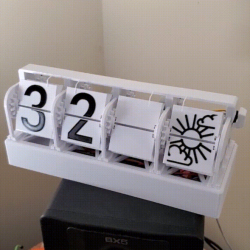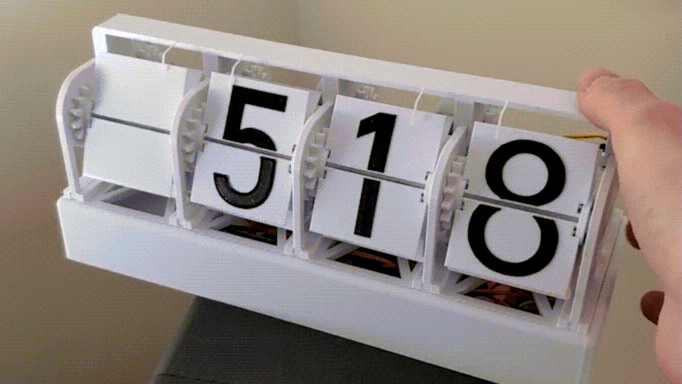With little more than four economical stepper motors, a Raspberry Pi Zero, and a 3D printer, [Thomas Barlow] made himself an awfully slick Smart Flip Clock that can display not only the time, but also weather data as well. This is done by adding a few extra graphics to some of the split-flaps, so numbers can also be used to indicate temperature and weather conditions succinctly. Displaying the time has to do without a colon (so 5:18 displays as 518), but being able to show temperature and weather conditions more than makes up for it.

According to the project’s GitHub repository, it looks as though each split-flap has thirteen unique positions. The first ten are for numerals 0 through 9, and the rest are either blank, or used to make up a few different weather icons with different combinations. A Python script runs on the Raspberry Pi and retrieves weather data from OpenWeather, and the GPIO header drives the display via four geared stepper motors and driver boards. The rest of the hardware is 3D printed, and [Thomas] helpfully provides CAD models in STEP format alongside the STL files.
The basic design of a split-flap display is really quite versatile, and enterprising hackers have been putting delightful new twists on them for years. There has been a split-flap display used as a kind of flip-book animation, and we’ve also had the pleasure of seeing an entire Tarot deck used for esoteric, automated readings.

















He’s made an effort, but the write up is terrible!
* The schematic is incomplete (where’s the switch?)
* There’s no indication of how to assemble the parts
* How does he (does he?) find the home-point of each wheel
It’s not all negative though – I like the idea of using thin 3d printed numerals!
So he is a bit of a hack? 🙄
I’ve never made plans before so all of this was new to me! Thanks for your comments, after reading this I updated the schematic to include the button that exists on the side of the clock. It accurately reflects the python code that is included in the repository.
I thought the assembly was obvious enough, but of course it would be to me: I designed it! I added a photo of the back of the clock that makes it a bit more clear where everything goes when it’s all done. This isn’t a set of instructions, but this should help anyone who is lost.
And you are correct! I don’t find the home point of each wheel. This is a decision I made to keep and complexity of this clock as low as I could so this isn’t included. Someone reached out to me as they made their own, and proposed an update that would include small magnets on each wheel and a small hall-effect sensor which would make for a brilliant solution for this problem.
Thanks for your comments! With a complex project like this I’m always open to “new-eyes” type comments that make it easier for people to digest and get involved if they choose too. Cheers!
Thomas, this is awesome and has been added to my project list as well as a co-worker’s. The question I have is there any chance you could make this use an arduino or pi-pico-w instead?
The price of a Pi Zero W even is a bit insane right now.
Love split flap displays and the weather is just the cherry on the top.